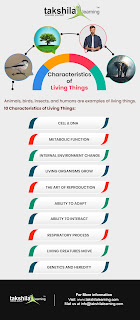10 Characteristics of Living Things Notes for Class 12
Cellular respiration allows animals to receive the energy that cells require to perform their jobs. Food is absorbed for energy, while waste is removed from the body. Birth, growth, reproduction, and death are the four stages of their life cycle.
Living creatures include animals, birds, insects, and people.
Converting, growing, reproducing, breathing, and transferring cells, DNA, and nourishment are all abilities that organisms possess. Scientists use these characteristics to distinguish natural elements from inorganic ones.
DNA & CELLS
Cells are the building blocks of all living things. Cells, which are arranged into groups such as organs, molecules, and other multicellular classifications, can reproduce, express themselves, and respond to particular stimuli, and are thus considered organisms by scientists.
METABOLIC ACTIVITY
He must ingest food and convert it into energy for his body in order to survive. All living creatures react inside, transforming the food they ingest into energy and transmitting it to the body's cells through digestion.
CHANGE IN THE INTERNAL ENVIRONMENT
Changes in the interior environment of organisms occur. The actions a body takes to protect itself are referred to as homeostasis. When the body cools, for example, heat is produced. This is a trait that all living things have.
GROWTH OF LIVING ORGANISMS
An organism must have cells that divide regularly to generate new cells in order to evolve. Life expands over time as cells grow, develop, and divide.
REPRODUCTION AS AN ART
Organisms develop and grow in order to produce additional organisms that are similar to themselves. It might happen as a result of sexual reproduction or the sexual reproduction of other creatures. A new organism's DNA is similar to that of the cell from whence it emerged.
ABILITY TO RESPOND TO CHANGES IN THE ENVIRONMENT
Plants, animals, humans, and even microorganisms may adapt to their surroundings. Adaptation refers to characteristics that aid an organism's survival in its environment. Through the season components, it's impossible to see the prey or the hunter changing the coat of numerous animals.
Read more

Comments
Post a Comment
Thank you we will contact ASAP.